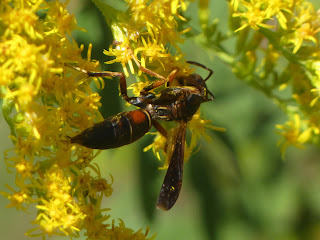Dark Paper Wasp
Bees aren't our only pollinators, as this Dark Paper Wasp demonstrates. The paper wasps are generally considered less aggressive than yellowjackets and hornets but will sting if they get the impression they or their nests are threatened.
Though named the Dark Paper Wasp, its darkness varies geographically. Generally speaking, well north of me (southern Canada or northern New York/New England) the yellow stripes will be on a black abdomen, while south of me (southern US) they tend to look more reddish.
These wasps are considered eusocial: they cooperate in raising young, multiple generations live together, and there's some specialization of duties. They're not as eusocial as some insects where soldiers, foragers, and tending to their young are distinctive jobs.
Their lifecycle is basically like this:
- At the end of summer, males and reproductive females grow to adulthood.
- This generation of males/females breed. The males then die while the new females congregate someplace sheltered to hibernate. (Note human dwellings are candidate locations for hibernating.)
- Older females, both reproductive or non-reproductive, die before winter. Only the recently mated females survive through the winter.
- In the spring, the females disperse. They'll chew up some wood and make small papery nests in which they'll lay eggs that will consist of non-reproductive females.
- Next the original female (foundress) will lay another set of eggs that will produce reproductive females with the help of the 1st set of non-reproductive females. (I'm assuming that males are also raised at the same time to breed with the new group of reproductive females.)
- As the new reproductive females become adults, we're really beginning to start a colony. Though they're generally subservient to the foundress female, they will be creating offspring of their own.
- The colony can reach around 200 wasps as the summer goes on.
- As the summer we return to #1.
This is one of the native species being outcompeted by an invasive invader, the European Paper Wasp.
 |
| September 19, 2021 at Duke Farms Photo 168281338, (c) jpviolette, some rights reserved (CC BY-NC) |



Comments
Post a Comment